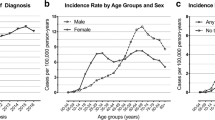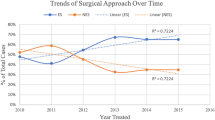Abstract
Invasive pituitary adenomas and pituitary carcinomas are clinically indistinguishable until identification of metastases. Optimal management and survival outcomes for both are not clearly defined. The purpose of this study is to use the Surveillance, Epidemiology, and End Results (SEER) database to report patterns of care and compare survival outcomes in a large series of patients with invasive adenomas or pituitary carcinomas. One hundred seventeen patients diagnosed between 1973 and 2008 with pituitary adenomas/adenocarcinomas were included. Eighty-three invasive adenomas and seven pituitary carcinomas were analyzed for survival outcomes. Analyzed prognostic factors included age, sex, race, histology, tumor extent, and treatment. A significant decrease in survival was observed among carcinomas compared to invasive adenomas at 1, 2, and 5 years (p = 0.047, 0.001, and 0.009). Only non-white race, male gender, and age ≥65 were significant negative prognostic factors for invasive adenomas (p = 0.013, 0.033, and <0.001, respectively). There was no survival advantage to radiation therapy in treating adenomas at 5, 10, 20, or 30 years (p = 0.778, 0.960, 0.236, and 0.971). In conclusion, pituitary carcinoma patients exhibit worse overall survival than invasive adenoma patients. This highlights the need for improved diagnostic methods for the sellar phase to allow for potentially more aggressive treatment approaches.

Similar content being viewed by others
References
Oruçkaptan HH, Senmevsim O, Ozcan OE, Ozgen T (2000) Pituitary adenomas: results of 684 surgically treated patients and review of the literature. Surg Neurol 53:211–219
Scheithauer BW, Kovacs KT, Laws ER Jr, Randall RV (1986) Pathology of invasive pituitary tumors with special reference to functional classification. J Neurosurg 65:733–744
Selman WR, Laws ER, Scheithauer BW et al (1986) The occurrence of dural invasion in pituitary adenomas. J Neurosurg 64:402–407
Scheithauer BW, Kurtkaya-Yapicier O, Kovacs KT et al (2005) Pituitary carcinoma: a clinicopathologic review. Neurosurgery 56:1066–1074
Beatriz M, Lopes S, Scheithauer BW et al (2005) Pituitary carcinoma. Endocrine 28:115–121
Chacko G, Chacko AG, Kovacs K et al (2010) The clinical significance of MIB-1 labeling index in pituitary adenomas. Pituitary 13:337–344
Hussaini IM, Trotter C, Zhao Y et al (2007) Matrix metalloproteinase-9 is differentially expressed in nonfunctioning invasive and noninvasive pituitary adenomas and increases invasion in human pituitary adenoma cell line. Am J Pathol 170:356–365
Lau Q, Scheithauer B, Kovacs K et al (2010) MGMT immunoexpression in aggressive pituitary adenoma and carcinoma. Pituitary 13:367–379
Pernicone PJ, Scheithauer BW, Sebo TJ et al (1997) Pituitary carcinoma: a clinicopathologic study of 15 cases. Cancer 79:804–812
Thapar K, Kovacs K, Scheithauer BW et al (1996) Proliferative activity and invasiveness among pituitary adenomas and carcinomas: an analysis using the MIB-1 antibody. Neurosurgery 38:99–107
Thapar K, Scheithauer BW, Kovacs K et al (1996) p53 expression in pituitary adenomas and carcinomas: correlation with invasiveness and tumor growth fractions. Neurosurgery 38:765–771
Kaltsas GA, Grossman AB (1998) Malignant pituitary tumours. Pituitary 1:69–81
Zada G, Woodmansee WW, Ramkissoon S et al (2011) Atypical pituitary adenomas: incidence, clinical characteristics, and implications. J Neurosurg 114:336–344
Kaltsas GA, Nomikos P, Kontogeorgos G et al (2005) Clinical review: diagnosis and management of pituitary carcinomas. J Clin Endocrinol Metab 90:3089–3099
Clarke SD, Woo SY, Butler EB et al (1993) Treatment of secretory pituitary adenoma with radiation therapy. Radiology 188:759–763
Grigsby PW, Simpson JR, Emami BN et al (1988) Prognostic factors and results of surgery and postoperative irradiation in the management of pituitary adenomas. Int J Radiat Oncol Biol Phys 16:1411–1417
Kovalic JJ, Mazoujian G, McKeel DW et al (1993) Immunohistochemistry as a predictor of clinical outcome in patients given postoperative radiation for subtotally resected pituitary adenomas. J Neurooncol 16:227–232
Pinchot SN, Sippel R, Chen H (2009) ACTH-producing carcinoma of the pituitary with refractory Cushing's disease and hepatic metastases: a case report and review of the literature. World J Surg Oncol 7:39
van der Klaauw AA, Kienitz T, Strasburger CJ et al (2009) Malignant pituitary corticotroph adenomas: report of two cases and a comprehensive review of the literature. Pituitary 12:57–69
Surveillance Epidemiology and End Results Program (2010) SEER*Stat database: incidence - SEER 17 regs research data + Hurricane Katrina impacted Louisiana cases, Nov 2010 sub (1973–2008 varying)-linked to county attributes–total U.S., 1969–2009 counties. Nov edn. National Cancer Institute, DCCPS, Surveillance Research Program, Cancer Statistics Branch
Surveillance Research Program, National Cancer Institute SEER*Stat software (seer.cancer.gov/seerstat) version 7.0.4
StataCorp. 2005. Stata Statistical Software: Release 9. College Station, TX: StataCorp LP 9
Raverot G, Wierinckx A, Dantony E et al (2010) Prognostic factors in prolactin pituitary tumors: clinical, histological, and molecular data from a series of 94 patients with a long postoperative follow-up. J Clin Endocrinol Metab 95:1708–1716
Grossman R, Mukherjee D, Chaichana K et al (2010) Complications and death among elderly patients undergoing pituitary tumour surgery. Clin Endocrinol 73:361–368
Benbow SJ, Foy P, Jones B et al (1997) Pituitary tumours presenting in the elderly: management and outcome. Clin Endocrinol 46:657–660
Cohen DL, Bevan JS, Adams CB (1989) The presentation and management of pituitary tumours in the elderly. Age Ageing 18:247–252
Rogne SG, Konglund A, Meling TR et al (2009) Intracranial tumor surgery in patients >70 years of age: is clinical practice worthwhile or futile? Acta Neurol Scand 120:288–294
Hong J, Ding X, Lu Y (2010) Clinical analysis of 103 elderly patients with pituitary adenomas: transsphenoidal surgery and follow-up. J Clin Neurosci 15:1091–1095
Sheehan JM, Douds GL, Hill K, Farace E (2008) Transsphenoidal surgery for pituitary adenoma in elderly patients. Acta Neurochir (Wien) 150:571–574
Delgrange E, Trouillas J, Maiter D et al (1997) Sex-related difference in the growth of prolactinomas: a clinical and proliferation marker study. J Clin Endocrinol Metab 82:2102–2107
Schaller B (2005) Gender-related differences in prolactinomas. A clinicopathological study. Neuro Endocrinol Lett 26:152–159
Schaller B (2003) Gender-related differences in non-functioning pituitary adenomas. Neuro Endocrinol Lett 24:425–430
Dudziak K, Honegger J, Bornemann A et al (2011) Pituitary carcinoma with malignant growth from first presentation and fulminant clinical course—case report and review of the literature. J Clin Endocrinol Metab 96:2665–2669
Conflict of interest
The authors have no conflict of interest.
Author information
Authors and Affiliations
Corresponding author
Additional information
Comments
Ludwig Benes, Arnsberg Germany
This well-written and interesting article deals with the rare pathologies of invasive pituitary adenomas and carcinomas collected over a 35-year time period. The data from a large series of 117 individuals suffering from these pathologies is illustrated comprehensively. Information is given regarding the role of genetic studies on this topic and also the prognostic significance of molecular markers. The authors nicely point out the differences in survival outcomes in these patients during a long follow-up period of 10 years underlining what most of the readers may have thought but could not really prove on the basis of a robust data analysis.
Paolo Cappabianca, Teresa Somma, Naples, Italy
The authors present a retrospective analysis pointing out the differences in terms of survival outcomes in patients with invasive pituitary adenomas and carcinomas over a 10-year follow-up period. Once again, the importance of early differential diagnosis has been emphasized to provide patients with an adequate treatment.
Though, this manuscript offers the possibility to draw many considerations.
The invasive adenoma is identified as a benign pituitary tumor, even if it exhibits an aggressive biological behavior, infiltrating the dura mater, cranial bone, or sphenoid sinus. Our experience constantly teaches us to warn these “false benign” lesions; they, indeed, require difficult management to achieve an adequate disease control. The pituitary carcinoma is defined as a tumor of the pituitary gland exhibiting cerebrospinal and/or systemic metastasis.
In our opinion, clinical evaluation of the patient needs to be completed by head and spinal MR and total body PET/CT to diagnose the presence of eventual metastasis indicative of a neoplastic progression. The metastatic dissemination more commonly involves the CSF axis, including virtually any site within the supratentorial, infratentorial, and spinal compartments. Extradural dissemination occurs less frequently and also exhibits less geographic restraint; bone, liver, lymph nodes, lung, kidney, and heart have all been reported as evidence of malignancy.
Furthermore, we believe that the genetic analysis can be useful not only to evaluate the biological behavior, as affirmed in the article, but also to define the therapeutic efficacy.
In the manuscript, the authors affirm the need of an aggressive treatment for these lesions.
We think that surgery must be completed by medical and radiation therapy.
The drug temozolomide has recently been documented to be effective against these lesions (1, 5, 7) especially if they show low levels of MGMT expression or present the immunopositivity of MSH6 (2, 4, 8), though new targeted therapies have been studied for lesions resistant to temozolomide (3, 6, 9). Finally, the radiotherapy plays an important role in the management of these lesions, especially in those of incomplete surgical resection and low effectiveness of medical treatment.
References
Colao A, Grasso LF, Pivonello R, Lombardi G. Therapy of aggressive pituitary tumors. Expert Opin Pharmacother. 2011 Jul;12(10):1561–70. doi: 10.1517/14656566.2011.568478. Epub 2011 Mar 24.
McCormack AI, Wass JA, Grossman AB. Aggressive pituitary tumours: the role of temozolomide and the assessment of MGMT status. Eur J Clin Invest. 2011 Oct;41(10):1133–48. doi: 10.1111/j.1365-2362.2011.02520.x. Epub 2011 Apr 18.
Jouanneau E, Wierinckx A, Ducray F, Favrel V, Borson-Chazot F, Honnorat J, Trouillas J, Raverot G. New targeted therapies in pituitary carcinoma resistant to temozolomide. Pituitary. 2012 Mar;15(1):37–43. doi: 10.1007/s11102-011-0341-0.
Kovacs K, Scheithauer BW, Lombardero M, McLendon RE, Syro LV, Uribe H, Ortiz LD, Penagos LC. MGMT immunoexpression predicts responsiveness of pituitary tumors to temozolomide therapy. Acta Neuropathol. 2008 Feb;115(2):261–2. Epub 2007 Oct 10.
Losa M, Mazza E, Terreni MR, McCormack A, Gill AJ, Motta M, Cangi MG, Talarico A, Mortini P, Reni M. Salvage therapy with temozolomide in patients with aggressive or metastatic pituitary adenomas: experience in six cases. Eur J Endocrinol. 2010 Dec;163(6):843–51. doi: 10.1530/EJE-10-0629. Epub 2010 Sep 24.
Ortiz LD, Syro LV, Scheithauer BW, Ersen A, Uribe H, Fadul CE, Rotondo F, Horvath E, Kovacs K. Anti-VEGF therapy in pituitary carcinoma. Pituitary. 2012 Sep;15(3):445–9. doi: 10.1007/s11102-011-0346-8.
Ortiz LD, Syro LV, Scheithauer BW, Rotondo F, Uribe H, Fadul CE, Horvath E, Kovacs K. Temozolomide in aggressive pituitary adenomas and carcinomas. Clinics (Sao Paulo). 2012;67 Suppl 1:119–23.
Salehi F, Scheithauer BW, Kros JM, Lau Q, Fealey M, Erickson D, Kovacs K, Horvath E, Lloyd RV. MGMT promoter methylation and immunoexpression in aggressive pituitary adenomas and carcinomas. J Neurooncol. 2011 Sep;104(3):647–57. doi: 10.1007/s11060-011-0532-6. Epub 2011 Feb 11.
Thearle MS, Freda PU, Bruce JN, Isaacson SR, Lee Y, Fine RL. Temozolomide (Temodar®) and capecitabine (Xeloda®) treatment of an aggressive corticotroph pituitary tumor. Pituitary. 2011 Dec;14(4):418–24. doi: 10.1007/s11102-009-0211-1.
Rights and permissions
About this article
Cite this article
Hansen, T.M., Batra, S., Lim, M. et al. Invasive adenoma and pituitary carcinoma: a SEER database analysis. Neurosurg Rev 37, 279–286 (2014). https://doi.org/10.1007/s10143-014-0525-y
Received:
Revised:
Accepted:
Published:
Issue Date:
DOI: https://doi.org/10.1007/s10143-014-0525-y




